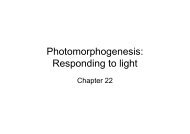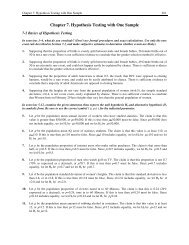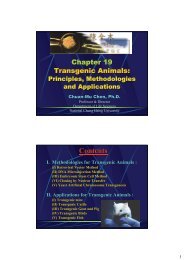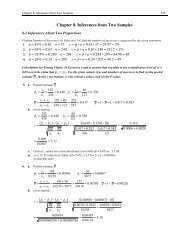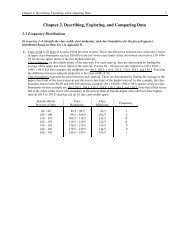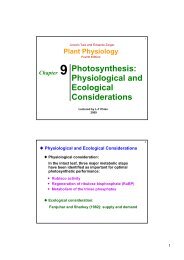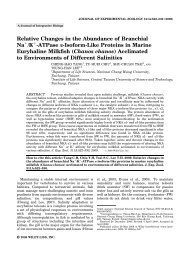Chapter 3. Probability
Chapter 3. Probability
Chapter 3. Probability
You also want an ePaper? Increase the reach of your titles
YUMPU automatically turns print PDFs into web optimized ePapers that Google loves.
88 <strong>Chapter</strong> 3: <strong>Probability</strong>SSs = = n −194.00=21−194.0020=4.700 = 2.168d. Variance= s 2 = 2.168 2 = 4.700e. Yes, if it had not been effective, it is likely the mean would be close to zero rather than 4,which was 1.85 standard deviations above zero.number above 0total number of scoresf. P(randomly selected would be positive)= = = 0. 857g. P(two selected, both positive)= P(first is positive) ∗ P(second is positive)=18/21 ∗ 17/20= 0.8571 ∗ 0.8500= 0.729h. P(18 out of 18 are positive)number of different sequences= 2 18 = 262,144number of ways all can be positive is oneP(18 out of 18 are positive)= 1/262,144= 0.00000381Yes, the treatment appears to be effective since the probability that this result could havehappened by chance when the program was not effective would be about four times outof a million.2. Women’s Heightsa. Mean height of adult women= 6<strong>3.</strong>6 in. (with a symmetrical distribution such as this one,the mean and median are the same and the median in the boxplot is 6<strong>3.</strong>6 in.b. P(height between 56.1 in. and 62.2 in.)= area between 56.1 in. and 62.2 in. = 0.25c. P(height below 62.2 in. or above 6<strong>3.</strong>6 in.) = P(below 62.2) + P(above 6<strong>3.</strong>6)=0.25 + 0.50= 0.75d. P(both between 62.2 and 6<strong>3.</strong>6 in.)= P(first one between) ∗ P(second one between)=0.250 ∗ 0.250= 0.0625e. P(two out of five taller than mean and three shorter than mean)number of sequences is 2 5 = 325!2!3!12012number of ways of getting 2 taller and 3 shorter is = = 1010 =321821P(two out of five taller than mean and three shorter than mean)= 0. 313




